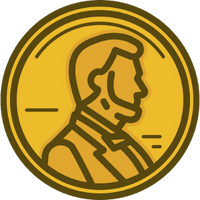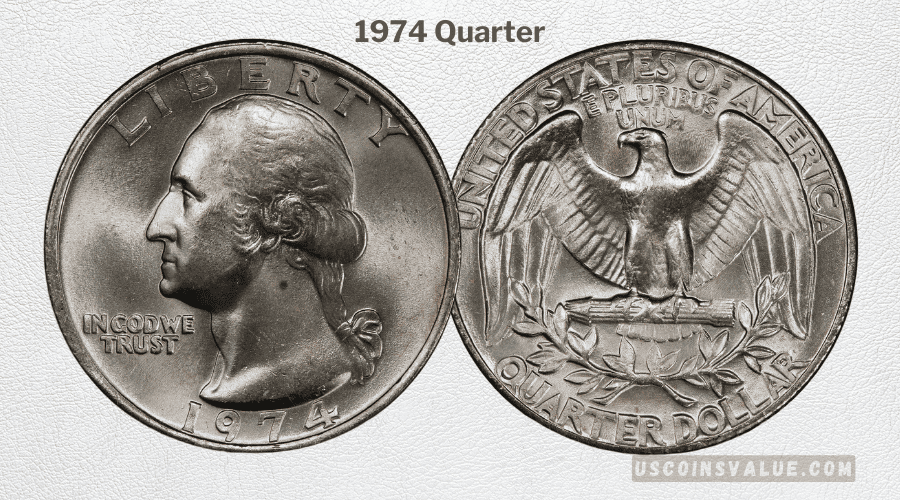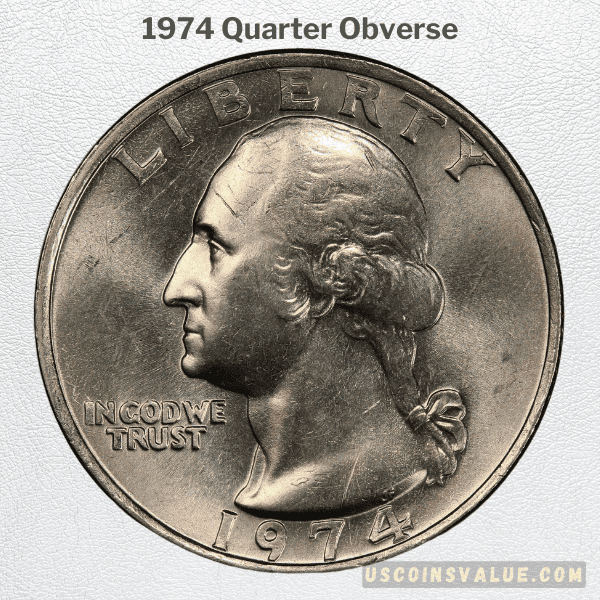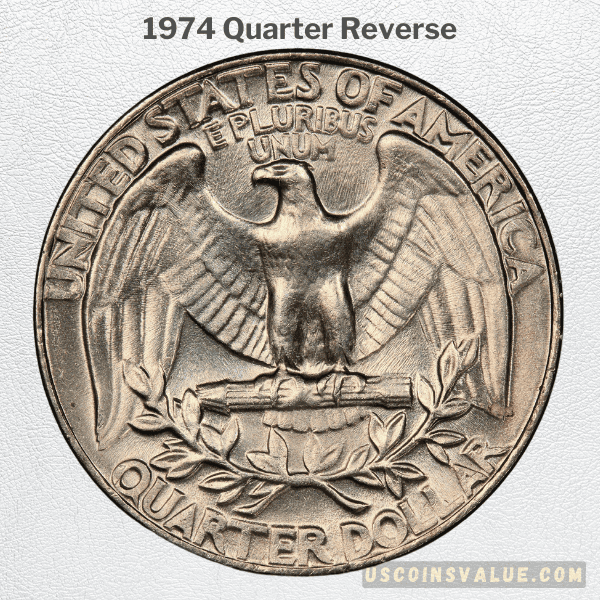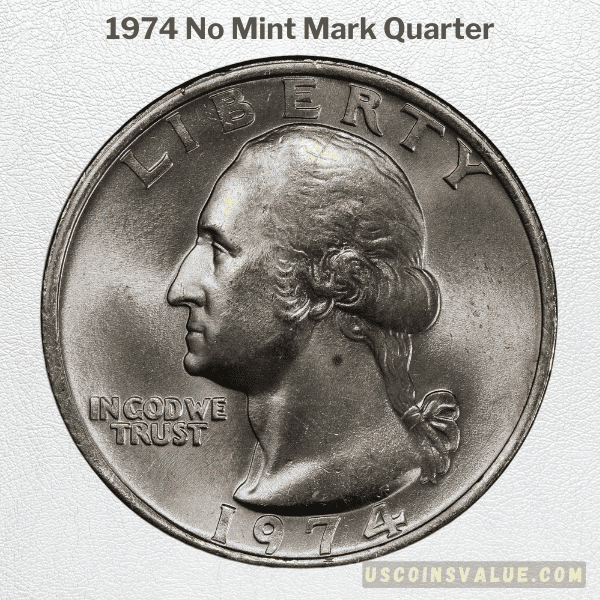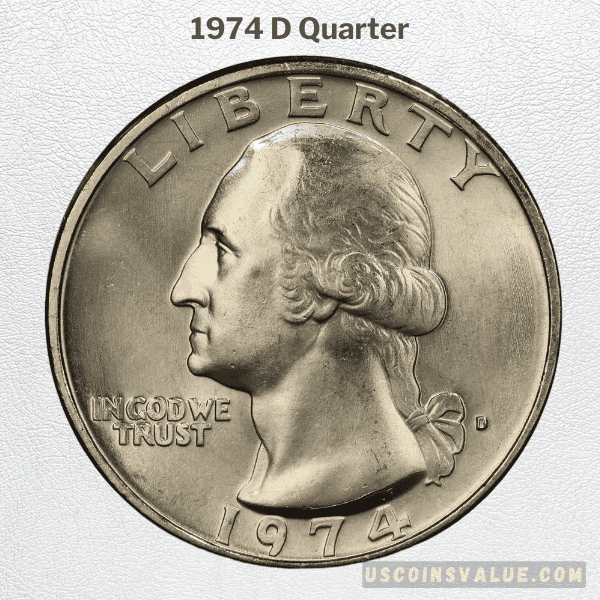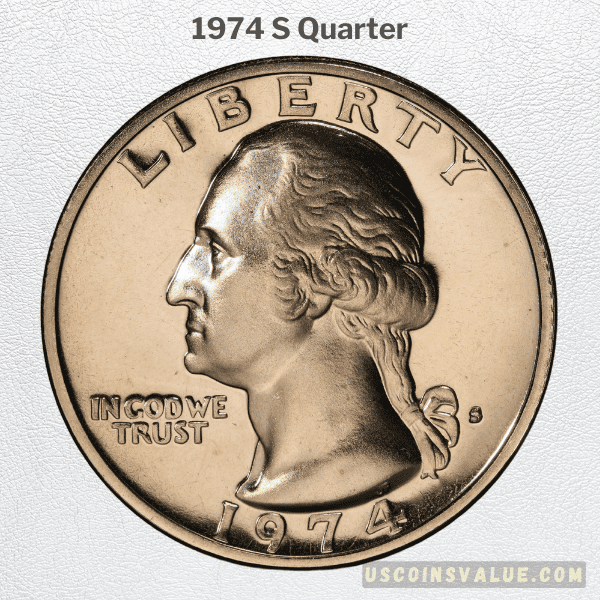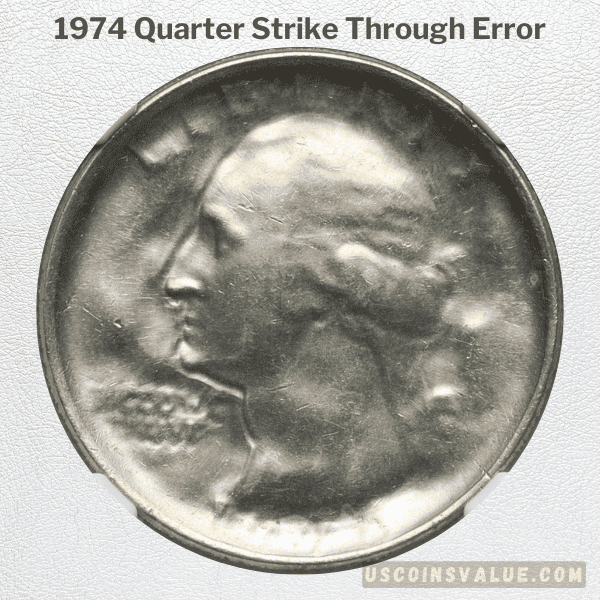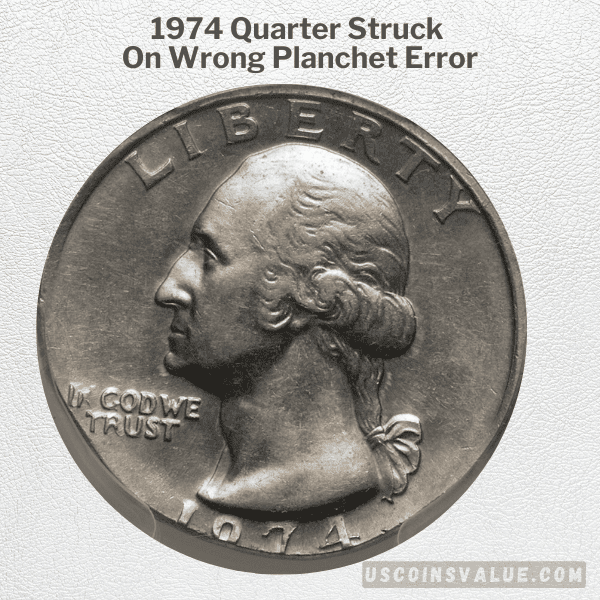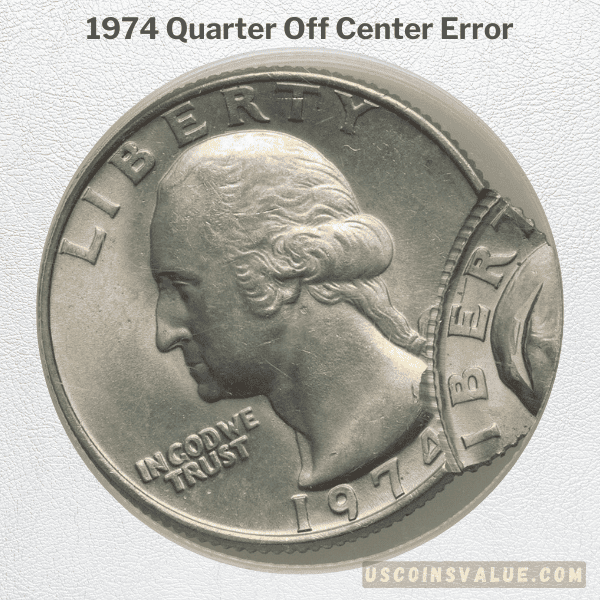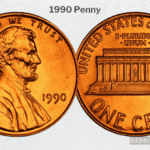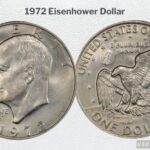If you’re like most coin collectors, you’re probably wondering will this 1974 Washington quarter fetch me huge bucks in the Numismatic world or is it only regular pocket change?
Although the U.S Mint struck and released millions of 1974 quarters, there are quite a few circulated quarters from this year that are highly coveted.
While an average 1974 Quarter value will fall between 25 – 80 cents, it can rise to $2,115. On one occasion, a 1974 quarter traded for a whopping $10,925.
To unravel the value of the 1974 quarter in your possession, you need to understand the role errors, conditions, and varieties play in determining a coin’s value. So, read on to start your journey to becoming a numismatist.
What is the History of the 1974 Washington Quarter?
This high-mintage coin is one of the most common coins you can find, and it often raises questions about its value. It is easily recognized and has been widely distributed since it made its debut.
Speaking of debut, the origin of this unique coin dates to as far back as 1932, when John Flanagan designed it as a tribute to the bicentennial celebration of George Washington’s birth.
The 1974 quarter was originally intended to be a commemorative piece that celebrated George Washington’s 200th birthday. However, it quickly became a crowd favorite and remained in circulation for much longer.
After that, the next coins to be minted were the unique 1776 – 1976 Bicentennial quarters, further commemorating the Bicentennial celebration.
John Flanagan designed both the obverse and reverse of the 1974 Washington quarter, which we’ll discuss shortly. For now, let’s consider its specifications and varieties.
The 1974 Washington Quarter Features
1974 quarter specifications:
- Category: Washington Quarters (1932 – 1998)
- Year of Make: 1974
- Mint Branch: Philadelphia, Denver, San Francisco
- Composition: 67% copper, 8.33% nickel.
- Weight: 5.67 grams
- Diameter: 24.3 millimeters
- Thickness: 1.75 millimeters (0.069 inches)
- Edge: Reeded
1974 Washington Quarter Varieties
Here’s one question we are sure you have on your mind, how many varieties of the 1974 quarter exist?
In 1974, three mints were responsible for the coinage of the 1974 quarters. These include the Denver, Philadelphia, and San Francisco Mint. Each Mint had the following mintage:
- Denver (D Mint Mark) = 353,160,300
- Philadelphia (No Mint Mark) = 801,456,000
- San Francisco (S Mint Mark) = 2,612,568
This amounted to 1,157,228,868 coins produced. For the 1974 quarter, the unique varieties include:
- 1974 Quarter No Mint Mark: These coins were minted in Philadelphia, but feature no mint mark.
- 1974 D Quarter: Minted in Denver and features the mint mark “D”.
- 1974 S Quarter: These are rare proof coins produced at the San Francisco mint. They typically feature the mint mark “S”.
Obverse & Reverse Design of The 1974 Quarter
Like all Washington quarters, the obverse of the 1974 quarter also features an image of George Washington, who, besides serving America from 1789 to 1797, also played an important role in drafting the U.S Constitution. The coin showcases these inscriptions:
- LIBERTY: Inscribed on the upper area of the coin, close to the left-facing portrait.
- IN GOD WE TRUST: At the lower left of the coin.
- 1974: Appears below the portrait.
On the reverse of the coin is the iconic American bald eagle with outspread wings. Its talons are latched onto a bunch of arrows, and it hovers above an olive branch. It features the inscriptions:
- UNITED STATES OF AMERICA: At the top of the coin.
- E PLURIBUS UNUM: Engraved at the upper area of the coin, just above the eagle’s head and below the “United States of America” inscription.
- QUARTER DOLLAR: At the bottom of the coin, just below the olive branch.
What Makes The 1974 Washington Quarter So Special?
So, you must be thinking, what makes this quarter so special, as long as you are concerned, since it was minted in large numbers, it should be no different than any regular coin.
It might interest you to know that it is regarded as a special coin because it was the last coin (for a couple of years) to feature the heraldic eagle on its reverse.
After the 1974 quarter came the dual dated bicentennial quarters and no 1975 quarters. Even coins struck in 1975 were marked 1776 to 1976.
Before 1965, 1974 quarters were minted from 40% silver, but due to rising silver prices, the coin was changed and was minted from copper and nickel.
How Much Is A 1974 Quarter Worth Now?
Over a billion 1974 Washington quarters were put out at the time of its minting. As such, you might find a good number of these coins here and there, with or without errors. However, this doesn’t mean they are worth nothing.
Additionally, the 1974 quarter must not have an error to be considered valuable. Its true value depends on its condition. MS (Mint State) and PR (Proof) coins are generally considered more valuable, and the higher the grade, the higher the price.
In the numismatic world, coins are graded from the lowest (P-1) to the perfect Mint State (MS-70). While they may be hard to come by, some 1974 Washington quarters have been found in perfect mint states, selling for thousands of dollars. We’ll discuss more on this later.
If you find a 1974 quarter in average circulated condition, it should be worth its face value, which is around 25 cents.
The NGC Price Guide places one of these quarters in circulated condition between $0.30 and $0.85. In uncirculated condition, it could sell for up to $275.
In its mint state, this coin can be traded for up to $14. However, it has a small melt value of $0.0571 due to its composition. The summary chart clearly shows these coins and how they are valued according to numismatics experts such as PCGS;
| 1974 Quarters
Grades |
1974
(M.S) |
1974-D
(M.S) |
1974-S (PR) |
| 60 | $1 | $1 | $4 |
| 61 | $1 | $1 | $4 |
| 62 | $2 | $2 | $5 |
| 63 | $5-$10 | $5-$8 | $7 |
| 64 | $18-$22 | $18-$25 | $8 |
| 65 | $26-$60 | $42-$60 | $12 |
| 66 | $274-$2,150 | $185-$1,350 | $13 |
| 67 | N/A | N/A | N/A |
| 68 | N/A | $1,508 | N/A |
| 69 | N/A | $2,693 | $11-$75 |
| 70 | N/A | $3,907 | $329 – $10,125 |
1974 Quarter No Mint Mark Value
The USACoinbook estimates the value of a 1974 quarter No Mint mark to be $6.81 in uncirculated, mint condition, with a melt value of $0.0521.
As of September 2023, The NGC Price Guide places its worth between $0.30 and $0.85. If you’re lucky enough to find a 1974 quarter with no mint mark, in pristine and uncirculated condition, it could sell for up to $1,500 in the open market.
Take a look at the highest auction records for the 1974 no mint mark quarter:
| Grade | Price | Firm | Sale Date |
| MS67 | $2,115 | Legend Rare Coins Auctions | 2020 |
| MS67 | $382 | Heritage Auctions | 2013 |
| MS67 | $374 | Heritage Auctions | 2007 |
| MS67 | $352 | Heritage Auctions | 2007 |
| MS67 | $252 | Heritage Auctions | 2018 |
1974-D Quarter Value
Following the NGC Price Guide, a 1974-D Washington Quarter is valued between $0.30 and $0.85 in circulated condition. In uncirculated condition, it could sell for up to $275.
The USACoinbook estimates the worth of an uncirculated 1974-D Quarter in MS65 to be $8.07, with a melt value of $0.0521.
The 1974-D Quarter has sold for a record price of $1,265 in 2006 and $1,150 in 2005. The table below shows the highest auction records for the 1974-D Quarter;
| Grade | Price | Firm | Sale Date |
| MS66 | $1,265 | Heritage Auctions | 2006 |
| MS67 | $1,150 | Heritage Auctions | 2005 |
| MS67 | $299 | Heritage Auctions | 2007 |
| MS67 | $299 | Heritage Auctions | 2007 |
| MS67 | $275 | Great Collections | 2013 |
1974-S Quarter (Proof)
Out of over a billion 1974 Washington quarters minted, only about 2.6 million were produced as proof coins, and these proof coins came from the San Francisco mint.
The 1974-S Washington quarters were struck as proof coins in Deep Cameo (DCAM) and Cameo (CAM) coinage gradings. Proof coins with CAM finishings are often highly reflective, with mirror-like contrasts and shiny lusters.
On the other hand, proof coins with DCAM finishings have frosty white or creamy designs and can appear black and white, making them highly sought-after.
Being made for collectors, they had fine finishings and high-quality exteriors and held no blemishes or irregularities.
As such, these proof coins hold more value than other varieties of the 1974 Washington quarter, with the highest recorded auction at $10,925 in 2009 at Heritage Auctions.
According to the USACoinbook, the 1974-S Washington Quarter has an estimated value of $5.84 and a melt value of $0.0521, while the NGC Price Guide estimates it at $13.75 in the open market.
Here are some of the highest auction records for the 1974-S Quarter Proof coins;
| Grade | Price | Firm | Sale Date |
| PR70 | $10,925 | Heritage Auctions | 2009 |
| PR70 | $9,200 | Heritage Auctions | 2010 |
| PR70 | $8,036 | Great Collections | 2014 |
| PR70 | $7,015 | Heritage Auctions | 2012 |
| PR70 | $3,290 | Heritage Auctions | 2015 |
1974 Quarter Errors To Look Out For
Although many coins go through a perfect minting process, finding error coins among the coins in circulation occurs quite often than you would expect.
The reasons for this could be traced to either the unstable minting equipment, malfunctions, or accidents. Depending on the type of error, the presence of an error can shoot up the value of a coin depending on the rarity of the error.
For the 1974 Washington quarter, there are quite a number of errors you can look out for. If found, you may have a highly valuable coin on your hands.
Some of these errors include;
- Chipped planchet errors
- Die crack errors
- Broadstruck errors
- Strike-through errors
- Wrong planchet errors, and several others.
Here’s a detailed analysis of what these different errors will look like if found on a 1974 quarter and how much they can fetch you in the numismatic world.
Strike-Through Quarter Error
This error occurs due to the interference of a foreign object when the coin is struck. The foreign object could be anything from a piece of wire to a string, capped die, bits of rag, or even the grease used to fill dies.
If there’s a foreign object between the die and the blank, it creates a mark that usually appears as a strike through the coin’s design.
An example is The 1974 25C Washington Quarter – Obverse Struck Through a Capped Die. This error coin-graded MS66 was sold for $288 at Heritage Auctions in 2019.
Struck On Wrong Planchet Error
Planchets are round metal disks that are plain just before they are struck to become coins. This error occurs when the coin is struck using the planchet for a different denomination. Due to the wrong planchet placement, these error coins usually have different colors, weights, and sizes.
This is a fairly common occurrence, and quite a number of 1974 Washington quarters with this error have sold for hundreds of dollars.
One of this category’s highest recorded error coins is The 1974 Washington Quarter – Struck on a 1C Blank. Graded MS64, it sold for $1,050 in 2020 at Heritage Auctions.
Here are some other wrong planchet errors;
- The 1974 Quarter – Struck on a Cent Planchet – MS63, which sold for $603.75 in 2002.
- The 1974-D Washington Quarter – Struck on a 3.09 gram 1C Planchet. Graded MS64, it sold for $1,150 in 2011.
- The 1974 Washington Quarter – Struck on a One Cent Blank – MS64, which weighed 3.1 grams and sold for $840 in 2023.
- The 1974 25C Washington Quarter – Struck on a 5C Planchet – AU58, which sold for $287.50 in 2012.
- The 1974 25C Quarter – Struck on a Nickel Planchet – MS63, which sold for $211.50 in 2013.
Off-Center Quarter Error
Off-center error coins are some of the most intriguing coins you can find. However, an off-center 1974 quarter would be pretty hard to find due to how rare they are.
This error happens when the strike on the coin is closer to the edge than to the center. An off-center coin typically ranges from 5% to 50% off-center, or even more. Usually, the higher the percentage, the more valuable the quarter is.
A typical 1974 off-center quarter is valued between $50 to $100. You can get up to $250 or more if the quarter shows 50% or more of the design with its complete date.
One of the highest record sales for such an error coin is the 1974 25C Washington Quarter Dollar – Double Struck, Second Strike 80% Off-Center. Graded MS63, it sold for $336 in 2021.
Other error coins in this category include;
- The 1974 25C Washington Quarter – Struck 10% Off-Center, which sold for $57 in 2021.
- The 1974 25C Washington Quarter – Struck 45% Off-Center, which sold for $94 in 2022.
1974 Quarter Silver Error
As mentioned, no Washington quarters bear the date 1975. Towards the final months of 1974, the U.S. Mint was gearing up to switch over to the 1776-1976 bicentennial coins, which were mostly struck on a 40% silver planchet.
It is believed that there may have been a few coins that were accidentally struck on such silver planchets. Most coin enthusiasts believe this may be a feasible error because coins produced during transitions like this were often accidentally struck on different metal planchets.
You can easily tell the difference between silver coins and copper–nickel-clad coins by their appearances. Silver coins have shiny and smooth textures, while coins with copper-nickel-clad compositions are matte with gray hues.
If your 1974 Washington quarter has silver composition, you can trade it for up to or more. However, a professional numismatist would have to verify its metal content as these coins are almost impossible to come by.
Final Thoughts
The 1994 Washington quarter is one of the most common yet intriguing coins. Due to its high mintage, it may be difficult to find one of great value, but possible.
This quarter holds a lot of sentiment for coin collectors because it was produced as a commemorative piece but stayed in use for about 66 years.
To determine the value of your Washington quarter, keep an eye out for its mintage and condition. Lower mintage coins are usually rare and, thus, have higher values. If you’re selling or buying a 1994 quarter, ensure you do your research and use only reliable auction houses to avoid paying for a fake quarter.
